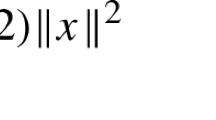Abstract
This paper is concerned with linear programming problems in which many of the constraints are handled implicitly by requiring that the vector of decision variables lie in a polyhedronX. It is shown that the simplex method can be implemented using a working basis whose size is the number of explicit constraints as long as the local structure ofX around the current point is known. Various ways of describing this local structure lead to known implementations whenX is defined by generalized or variable upper bounds or flow conservation constraints. In the general case a decomposition principle can be used to generate this local structure. We also show how to update factorizations of the working basis.
Similar content being viewed by others
References
A.I. Ali, R.V. Helgason, J.L. Kennington and H.S. Lall, “Primal simplex network codes: state-of-the-art implementation technology”,Networks 8 (1978) 315–339.
A.A. Assad, “Multicommodity network flows—a survey”,Networks 8 (1978) 37–91.
R.H. Bartels, “A stabilization of the simplex method”,Numerische Mathematik 16 (1971) 414–434.
R.H. Bartels, G.H. Golub and M.A. Saunders, “Numerical techniques in mathematical programming”, in: J.B. Rosen, O.L. Mangasarian and K. Ritter, eds.,Nonlinear programming (Academic Press, New York, 1970) pp. 123–176.
A. Ben-Israel and A. Charnes, “An explicit solution of a special class of linear programming problems”,Operations Research 16 (1968) 1166–1175.
G.H. Bradley, G.G. Brown and G.W. Graves, “Design and implementation of large scale primal transshipment algorithms”,Management Science 24 (1977) 1–34.
S. Chen and R. Saigal, “A primal algorithm for solving a capacitated network flow problem with additional linear constraints”,Networks 7 (1977) 59–79.
R.C. Daniel, “A note on Schrage's generalized variable upper bounds”,Mathematical Programming 15 (1978) 349–351.
G.B. Dantzig,Linear programming and extensions (Princeton University Press, Princeton, NJ, 1963).
G.B. Dantzig, “Compact basis triangularization for the simplex method”, in: R.L. Graves and P. Wolfe, eds.,Recent advances in mathematical programming (McGraw-Hill, New York. 1963) pp. 125–132.
G.B. Dantzig and R.M. van Slyke, “Generalized upper bounding techniques”,Journal of Computer System Sciences 1 (1967) 213–226.
G.B. Dantzig and P. Wolfe, “The decomposition algorithm for linear programming”,Econometrica 29 (1961).
J.J.H. Forrest and J.A. Tomlin, “Updating triangular factors of the basis to maintain sparsity in the product form simplex method”,Mathematical Programming 2 (1972) 263–278.
P.E. Gill and W. Murray, “A numerically stable form of the simplex algorithm”,Journal of Linear Algebra and its Applications 7 (1973) 99–138.
P.E. Gill and W. Murray, “Linearly-constrained problems including linear and quadratic programming”, in: D.A.H. Jacobs, ed.,The state of the art in numerical analysis (Academic Press, London, 1977).
P.E. Gill, W. Murray and M.A. Saunders, “Methods for computing and modifying theLDV factors of a matrix”,Mathematics of Computation 29 (1975) 1051–1077.
F. Glover, D. Karney and D. Klingman, “Implementation and computational comparison of primal, dual and primal-dual computer codes for minimum cost network flow problems”,Networks 4 (1974) 191–212.
G.W. Graves and R.D. McBride, “The factorization approach to large-scale linear programming”,Mathematical Programming 10 (1976) 91–110.
M.D. Grigoriadis and W.W. White, “A partitioning algorithm for the multicommodity network flow problem”,Mathematical Programming 3 (1972) 157–177.
R. Gupta, “Solving the generalized transportation problem with constraints”,Zeitschrift für Angewandte Mathematik und Mechanik 58 (1978) 451–458.
J.K. Hartman and L.S. Lasdon, “A generalized upper bounding algorithm for multicommodity network flow problems”,Networks 1 (1972) 333–354.
E.L. Johnson, “Networks and basic solutions”,Operations Research 14 (1966) 619–624.
M. Kallio and E.L. Porteus, “Triangular factorization and generalized upper bounding techniques”,Operations Research 25 (1977) 89–99.
J.L. Kennington, “A survey of linear cost multicommodity network flows”,Operations Research 26 (1978) 209–236.
D. Klingman and R. Russell, “Solving constrained transportation problems”,Operations Research 23 (1975) 91–106.
L.S. Lasdon,Optimization theory for large systems (Macmillan, New York, 1970).
S. Maier. “A compact inverse scheme applied to a multicommodity network with resource constraints”, in: R.W. Cottle and J. Krarup, eds.,Optimization methods for resource allocation (English Universities Press, 1972).
H.M. Markowitz, “The elimination form of the inverse and its application to linear programming”,Management Science 3 (1957) 255–269.
R.D. McBride, “A bump triangular dynamic factorization algorithm for the simplex method”,Mathematical Programming 18 (1980) 49–61.
B.A. Murtagh and M.A. Saunders, “Large-scale linearly constrained optimization”,Mathematical Programming 14 (1978) 41–72.
J.K. Reid, “A sparsity-exploiting variant of the Bartels-Golub decomposition for linear programming bases”, Report CSS 20, Computer Science and Systems Division, A.E.R.E. Harwell (1975).
R. Saigal, “Multicommodity flows in directed networks”, ORC67-14, Operations Research Center, University of California at Berkeley, Berkeley, CA (1967).
M.A. Saunders, “A fast, stable implementation of the simplex method using Bartels-Golub updating”, in: J.R. Bunch and D.J. Rose, eds.,Sparse matrix computations (Academic Press, New York, 1976), pp. 213–226.
L. Schrage, “Implicit representation of variable upper bounds in linear programming”,Mathematical Programming Study 4 (1975) 118–132.
L. Schrage, “Implicit representation of generalized variable upper bounds in linear programming”,Mathematical Programming 14 (1978) 11–20.
V. Srinivasan and G.L. Thompson, “Benefit-cost analysis of coding techniques for the primal transshipment algorithm”,Journal of the Association for Computing Machinery 20 (1973) 194–213.
M.J. Todd, “An implementation of the simplex method for linear programming problems with variable upper bounds”,Mathematical Programming 23 (1982) 34–49.
J.A. Tomlin, “Generalized upper bounding and triangular decomposition in the simplex method”,Operations Research 22 (1974) 664–668.
Author information
Authors and Affiliations
Additional information
This research was initiated while the author was visiting at D.A.M.T.P. University of Cambridge, England, and was supported by fellowships from the John Simon Guggenheim Foundation and the Alfred P. Sloan Foundation and by National Science Foundation grant ECS-7921279.
Rights and permissions
About this article
Cite this article
Todd, M.J. Large-scale linear programming: Geometry, working bases and factorizations. Mathematical Programming 26, 1–20 (1983). https://doi.org/10.1007/BF02591889
Received:
Accepted:
Issue Date:
DOI: https://doi.org/10.1007/BF02591889



